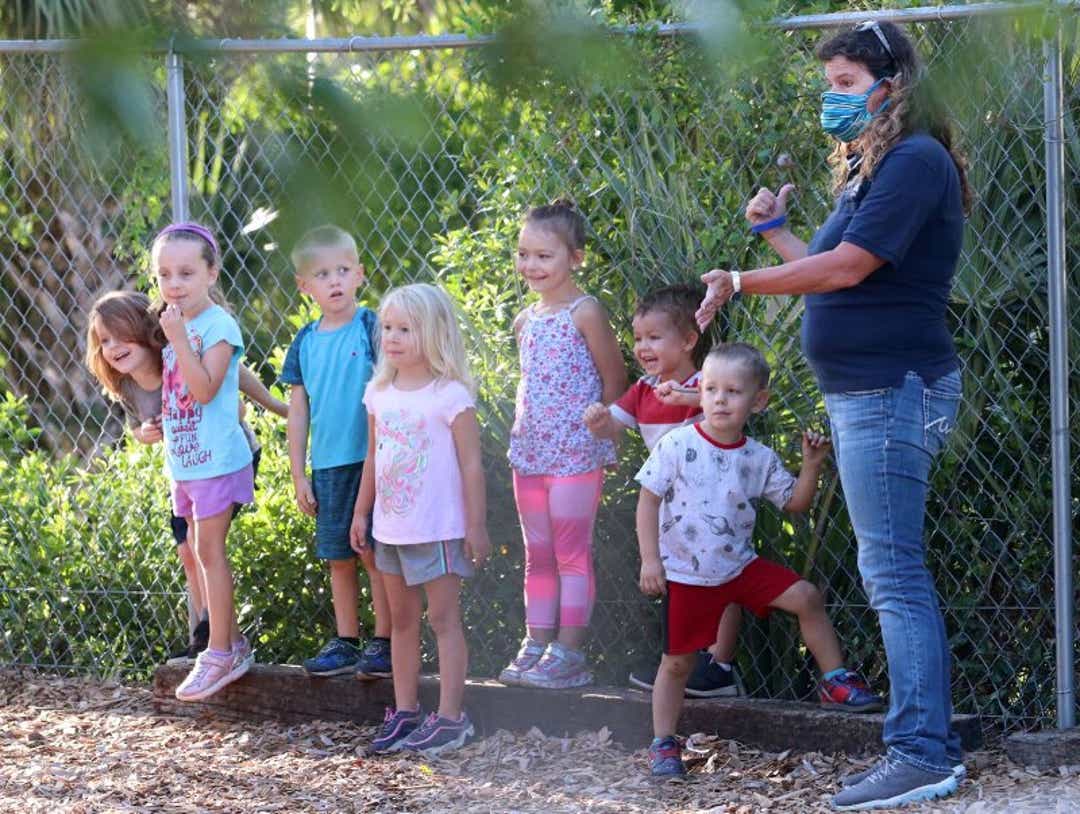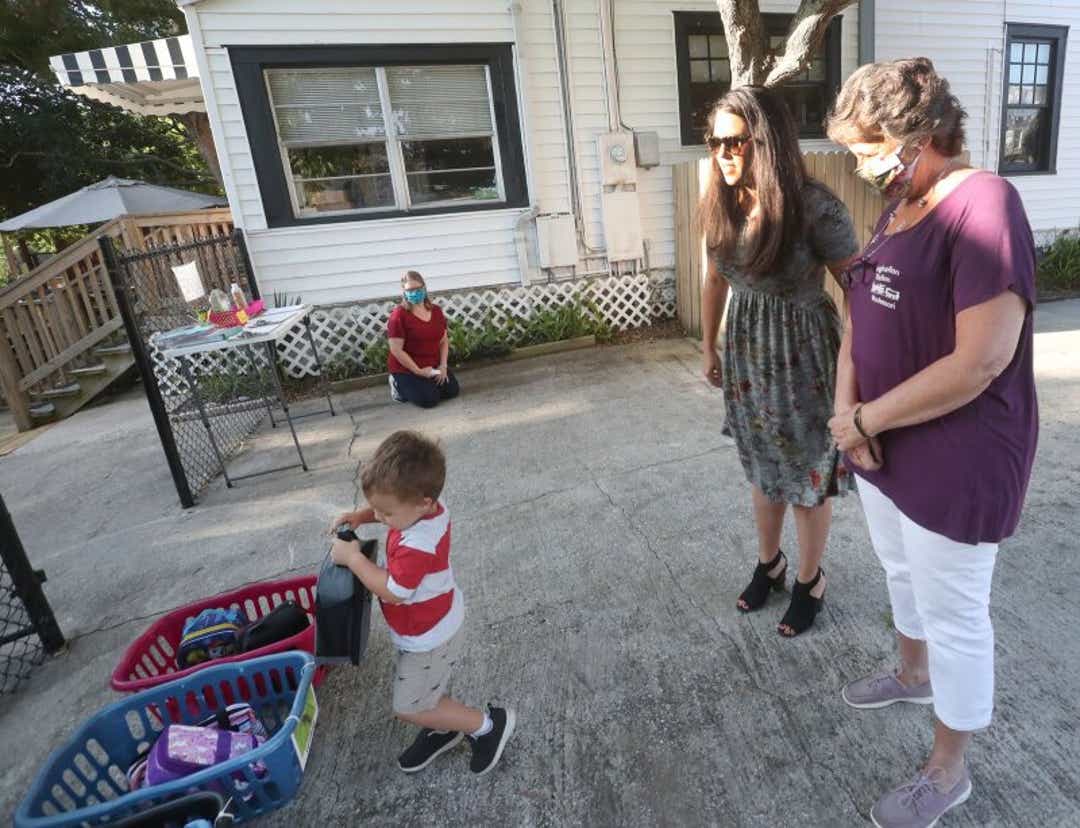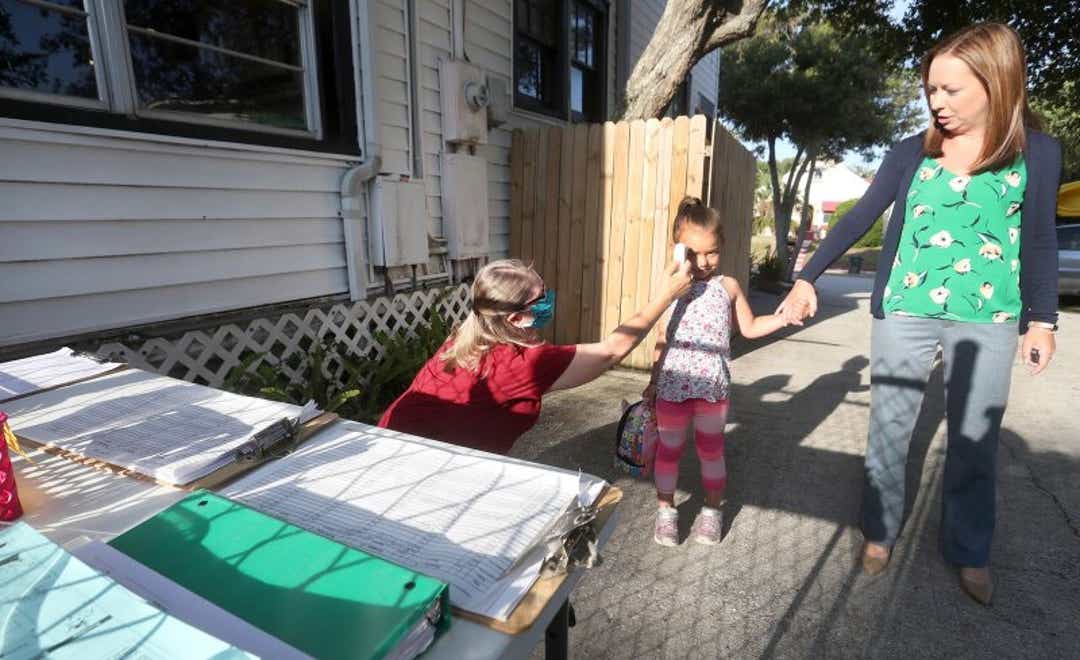Child care during the coronavirus pandemic can best be described as clinical.
Temperature checks, hand-washing and face masks are constants now at preschools and child care centers around the country. Class sizes have limits, and some lunchrooms and common areas are off limits. The safety measures pose a constant reminder to families: These are not normal times.
As parts of the country begin to tip-toe back toward more normal routines, working parents are desperate for child care. Still, they must weigh the risks of sending their young children outside of the safety of their homes, to be cared for by someone else.
The big question: Is it safe?
“We don’t know,” summarized Dr. Danette Glassy, a Seattle-area pediatrician. “There’s no scientific answer to that question until we have more time under our belts.”
Instead, experts say, parents and day care providers must consider the size of the outbreak in their area and commit to health and safety measures recommended by the U.S. Centers for Disease Control and Prevention. The goal: reduce exposure to the virus wherever possible.
Coronavirus closed day cares: Child care providers worry they may never reopen

Situated a few blocks from the ocean, Imagination Station in Daytona Beach, Florida, was closed all through April. Now children are back at the facility every day — but they play with the same small groups of classmates, wash their hands over and over, and only play with toys that can be easily cleaned. Owner Kim Vukelja said she reopened because her employees wanted to come back to work.
“You’re on a precipice,” she said. “You don’t know which way to go.”
Enrollment is still a fraction of what it usually is, but the parents who are sending their kids each day are grateful for the help.
“Basically, we felt the virus is not going to go anywhere,” Melissa Owens said as she dropped off her 4-year-old daughter Cora at Imagination Station. She works for an agency that staffs clinical labs, like the ones that are processing coronavirus tests. “We just need to be vigilant to make sure our school is going to keep students and parents safe with all the protocols.”
At Imagination Station, those protocols include only allowing one parent to pick up or drop off their child, at assigned and staggered times. A teacher in a mask takes the child’s temperature with a contactless thermometer before they can go inside. Children have to deposit their lunchboxes in class-specific bins so there’s less cross-contamination. They go to the playground and then must wash their hands before they do anything else. Their parents may not come inside.

Children of healthcare workers, first responders and other essential workers have already returned to daycares in almost every state, following similar routines.
For many parents, it’s more than a safety decision. It’s an economic one. Many parents cannot work if they cannot send their children somewhere during the day.
Figuring out if that’s a good idea will depend on a lot of different factors, said Dr. Kate Connor, an assistant professor of pediatrics at Johns Hopkins University and the medical director of The Rales Health Center at KIPP Baltimore, a charter school.
“‘Safe’ is a relative term now,” Connor said. “All of these things are sort of risk-reduction traits essentially, but none of them will be 100%, particularly if COVID is still circulating in the community.”
Where you live matters
First, providers and parents must consider the infection rate in their community. There are nearly 1.5 million confirmed cases in the U.S., but the actual number is likely much higher.
US coronavirus map: Tracking the outbreak
Ideally, where child care providers reopen, there will have been at least two weeks of declining or plateauing hospitalizations and deaths, Connor said. There will be enough testing to identify new cases. And there will be enough people in the public health network who are trained in contact tracing: tracking where infected people have been and notifying people who might have been exposed.
All of that is hard for ordinary people to discern on their own. That’s why state-specific information like stay-at-home orders and guidance on phased reopenings is so important. Every day, state officials announce updates and ease restrictions based on what they see.
Still, if a state is reopening, that doesn’t necessarily mean everything is fine.
“You will still have to always assume that the person you’re interacting with could have COVID,” Glassy said.

Children are less likely to show symptoms of COVID-19 than adults, early numbers suggest. One study found children accounted for less than 2% of almost 150,000 confirmed U.S. cases.
What’s still unclear is how big of a role children may play in the spread of the virus to adults. And adults and children with compromised immune systems or pre-existing conditions are always at increased risk.
'Almost all the kids are treatable': What parents should know about new COVID-related inflammatory disease
What to look for in a day care
For families who need to start using child care again, Glassy and Connor advise checking with the provider about what mitigation measures they have in place.
Depending on the outbreak in their area, states are taking guidelines from the CDC and translating them into regulations for operation. They have some common traits.
Commonly, class sizes are limited and kept to a ratio of nine children to one adult. The ratio is lower for younger children or infants, and some states, such as Ohio, have created lower class-size limits for children of all ages.
Child care providers should wear masks where possible, especially when in close contact with younger children. Providers should screen children for symptoms when they arrive each day, by taking their temperature or asking about symptoms. Children and adults who have any symptoms associated with coronavirus should stay home. Everyone should wash their hands, a lot.

Social distancing guidelines are the hardest for child care centers to reinforce. Outside of members of the same own household, the CDC recommends staying six feet away from other people.
But that becomes difficult in small facilities where one adult is caring for multiple children at a time. Plus, young kids by nature play in close quarters with each other. It’s even good for their development.
“This is really hard because this is sort of the fabric of what child care centers do,” Connor said.
More examples: What reopened child care centers look like in Middle America
Under the new coronavirus reality, many child care providers are trying to keep children around a small group of the same people each day. For instance, separate classes no longer have lunches together at a long table or mix on the playground. Providers try to be strict about all the other protective measures, knowing social distancing will be a struggle.

In Sommerville, New Jersey, Tirusha Dave took a few extra measures when she opened Ellie’s Academy for essential workers. She requires her students to change their shoes when they get in, and she asked her workers to limit food deliveries to the facility.
Additionally, she’s required to send attendance logs, temperature logs and information about possible exposure for her students to the state regularly.
Vukelja, in Daytona Beach, doesn’t have to meet those tracking requirements — but she had her families and employees sign a contract that they would minimize contact with other people outside of their families and the preschool.
Asking questions about a facility’s protective measures becomes even more important in an era where parents aren’t allowed into the facilities they’re sending their children. Day care tours have been suspended as a way to keep out unnecessary people. Dave said some of her families have never even met the teacher who is with their children all day.
“They’re leaving their kids somewhere where they can’t even have a tour of the building,” Dave said. “It’s a matter of trust that they have, that they’re handing their child off to somebody who’s healthy and safe and secure.”

The future of child care
Providing child care during a pandemic comes at a cost. There’s the purchase of protective equipment, the limits to class sizes, declining enrollment and therefore revenue — all in a business with notoriously low profit margins. As some centers regroup and reopen, others will stay closed. Down the line, as more and more parents return to work and need child care again, they could find their day care provider is out of business.
Child care in the U.S. was already a problem: America's parents want paid family leave and affordable child care. Why can't they get it?
National child care and early education advocates say child care providers need federal aid, and soon.
An analysis from The National Women’s Law Center estimates Congress would have to allocate $50 billion for less than six months of relief and emergency care. The CARES Act stimulus passed this spring provided money for essential workers to pay for child care, but experts say it’s not enough.
“We are gonna be the biggest part of a comeback, besides people going to work: having a place to put their children that they can trust and feel comfortable with,” said Cindy Lehnhoff, director of the National Child Care Association. “It’s going to be hard if we don’t do something to keep providers like (Imagination Station) open.”
Of the 244,000 licensed child care facilities and in-home care providers in the U.S., 60% were forced to close due to the pandemic, Lehnhoff said. Of those, 30% to 50% are projected never to reopen. The carnage will leave millions of children without a place to go and thousands of workers without a job. And that will put more stress on an already-strained system.
“So far, with so few children, it’s working very well,” Vukelja said. “I don’t know what the fall is going to be like.”
Follow Cassidy Alexander on Twitter: @bycassidy
"care" - Google News
May 18, 2020 at 04:04PM
https://ift.tt/2ZifCFl
Is day care safe during the coronavirus pandemic? It depends. Here are some guidelines. - USA TODAY
"care" - Google News
https://ift.tt/2N6arSB
Shoes Man Tutorial
Pos News Update
Meme Update
Korean Entertainment News
Japan News Update
Bagikan Berita Ini















0 Response to "Is day care safe during the coronavirus pandemic? It depends. Here are some guidelines. - USA TODAY"
Post a Comment